Dye Jars

With the transition to modern chemical dyes, storage has become necessary. Dyes can be saved for months (if used frequently) or even years. And, with refrigeration, botanical dyes can be saved for longer periods of time. What should you use to store them?
A container that is leakproof is best; otherwise, dye can spill and evaporate. Most pysanka makers use jars of some sort–the choice you need to make is “glass or plastic?” Glass has the disadvantage of being heavy and being breakable; it is variably heat tolerant. Plastic is light and, generally, unbreakable, but the myriad varieties of plastic run the gamut of other characteristics, including heat tolerance. (Heat tolerance in this instance is taken to mean the response of the substance to boiling water; non-tempered glass can crack, some plastics will melt.)
Glass Jars (Commercial): These containers are ubiquitous and cheap. Almost everyone has jelly, jam, peanut butter or pickle jars laying around. These commercial containers can be recycled into storing pysanka dyes. If you chose to use these, keep two things in mind:
-
1.Many commercial jars have metal lids, and these will rust if used to store aniline (or other acid) dyes. The rust granules will fall into and contaminate the dyes over time. They can be strained out quite simply, but the lids will eventually need to be replaced.
-
2.The jars are NOT made of tempered glass, and can easily crack if boiling water is poured into them. Placing a spoon into the jar while pouring can help prevent this–the metal spoon acts as a heat sink. Better yet, mix up the dye in a safe container--a saucepan or a Pyrex measuring cup–and then pour into the jar after it has cooled a bit.
My first dye jars were Smuckers jelly jars, and I kept them for many years, changing the lids occasionally. The old Smuckers jars were wide mouth, unlike the current incarnation. They were a good size, with room inside for 1.5 cups of dye and two eggs without spilling. The lids screwed on, and sealed tightly, without leakage.
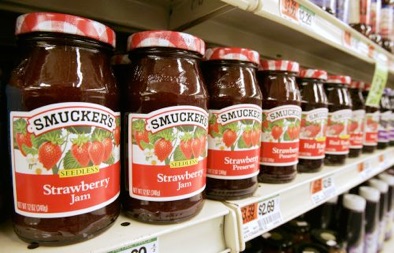
A problem with all glass jars is that they are a very hard surface, and you have to be very careful when placing eggs into the jars. The eggs are more likely to crack than those placed into a plastic container.
PROS: usually free, a form of recycling. Usually leakproof.
CONS: glass not tempered, can crack with heating or even if knocked too frequently with metal spoons. Lids, if metal, will rust, can be difficult to replace. May crack eggs. Jars heavier, bulkier and more breakable than plastic jars.
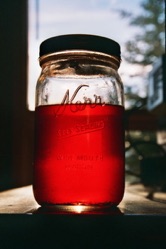
Mason jar have the advantage for being made to be boiled and heated. It is safe(r) to mix up dyes in mason jars than in commercial glass jars, but you should still use a metal spoon as a heat sink.
They have the disadvantage of (generally) having metal lids. These will rust. On the plus side, you can buy new lids to replace them quite easily, as opposed to commercial lids. You can also replace the metal lids and screw tops with plastic replacement lids (below).
Mason jars come in several sizes, none of which are ideal for pysanky. commercial jars come in more sizes and shapes, some of which might be a better fit. The cup sized jars (used for jams and jellies) are much too small. The quart jars are very large and tall, making putting the eggs in and taking them out more awkward.
The pint sized jars are actually a very nice size if you only plan to dye one egg at a time. They will hold the egg and dye with a bit of room to spare. They are not useful if you plan to dye multiple eggs. Additionally, if you are just starting out, you can buy a case of these jars quite cheaply (around $10), and mix up a full set of dyes. The box the jars come in makes quite good storage:
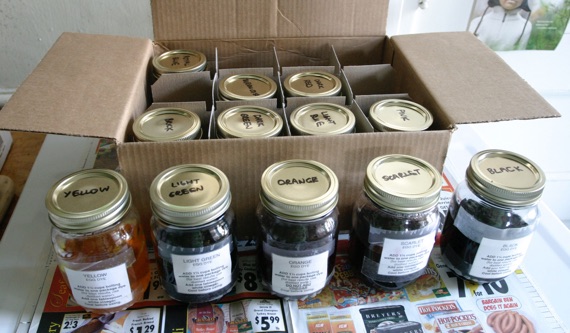
The screw top lids are water tight, which is a very good thing, but will eventually rust. It is worthwhile, if you plan to keep using these jars, to replace them rings with plastic lids, which are commercially available.
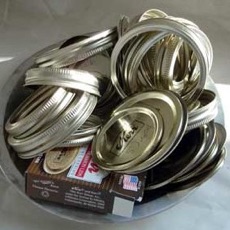

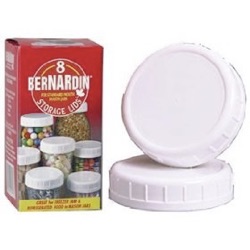
You may still need the metal lids with the plastic lids to keep the seal watertight; such lids vary. Alternatively, you can place a piece of Saran wrap over the jar opening and use a ring or plastic lid with that.
One last consideration, if you are buying jars, or if you have a large variety to choose from, is the width of the opening. Mason jars come in regular and wide-mouth varieties. The wide-mouth jars have a much larger opening, making it easier to put eggs into the jar and remove them, making it much less likely that you will drop the egg and break it. The wide-mouth pint jars are particularly nice:
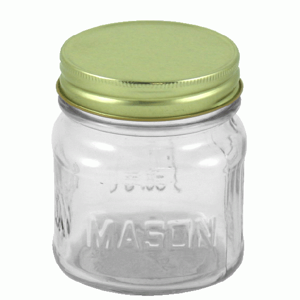
PROS: Often free. Strong glass, heat tolerant. Ubiquitous. Leakproof. Plastic lids available. Wide mouth variety available.
CONS: Eggs may crack due to hard surface. Jars heavier, bulkier and more breakable than plastic jars. Metal lids rust.
PLASTICS come in many varieties. Today most plastic containers have a three arrow recycling code imprinted on them; this can be useful in identifying their type and assessing their suitability for various tasks. There are six types, plus a Type 7 “Other.”
Type 1 - PETE Polyethylene Terephthalate (PET): Soda & water containers, some waterproof packaging.
Type 2 - HDPE High-Density Polyethylene: Milk, detergent & oil bottles. Toys and plastic bags. Can withstand 110 °C /230 °F
Type 3 - V Vinyl/Polyvinyl Chloride (PVC): Food wrap, vegetable oil bottles, blister packages. May produce dioxin during degradation.
Type 4 - LDPE Low-Density Polyethylene: Many plastic bags. Shrink wrap, garment bags.
Type 5 - PP Polypropylene: Refrigerated containers, bags, most bottle tops, some carpets, some food wrap.
Type 6 - PS Polystyrene: Throwaway utensils, meat packing, protective packing.
Type 7 - OTHER: Usually layered or mixed plastic. No recycling potential.
Luckily deciding which type of plastic jar to use is not as complicated as it might be. Only two types of plastic are commonly used for jars: Types 1 (Polyethylene Terephthalate) and 5 (Polypropylene).
Plastic Jars (Type 1): Polyethylene is a hard, waterproof material, and it’s what your two liter Coke bottles are made from. It is useful for storing fluids. What it is not good for is tolerating boiling liquids. Heating a container made from polyethylene to the temperature of boiled water will melt/deform it.
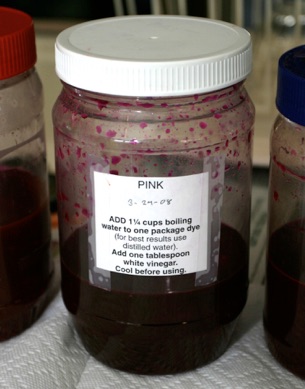
However, as I have learned through experience, pouring boiling water into one of these containers is a bad idea. It won’t rupture or leak, but the jar will begin to melt and will change shape, getting twisted and squat.
It is easy enough to avoid this problem by simply mixing up the dyes in another container–in my case, as Pyrex measuring cup (2 cup size). With the pyrex cup I don’t have to worry about breaking glass, either, as it is very heat resistant. Once the dye has cooled off, I simply pour it into the plastic jar for storage.
One tip I have picked up over the years is to tape the dye packet (or a piece of it) to the jar, and write the date I mixed up the dye on it (left). This aids me in knowing when to add more vinegar, and when a dye probably need replacing.
A significant disadvantage of these jars is their price. They cost about $3.00 each. This was not unreasonable at the time I bought them (there were no better alternatives), but is expensive today, when so many other alternatives are available.
PROS: Leakproof lids, don’t rust. Virtually unbreakable, lightweight jars.
CONS: plastic does not tolerate heat. Relatively expensive.
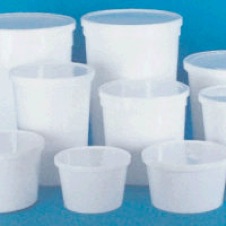
I’ve used quart soup containers that I get for free from my local Chinese restaurant to mix up and store dyes, and for many other purposes (vinegar rinse, chemical wax removal, etc.).
Since these containers are quite heat resistant, they can be used not just to mix up dyes, but to reheat them, as is sometimes done if dyes precipitated out of solution and form a granular or solid mass at the bottom of the jar. Boiling them will put the dye particles back into solution.
When the lid is applied properly, these jars are completely watertight, and will store dyes without any noticeable evaporation. If the lid is not sealed properly, the jars can leak.
I have found these jars useful for taking with me when I’ve taught classes in Ukraine and India; the jars stack nicely and are quite lightweight, perfect for packing.
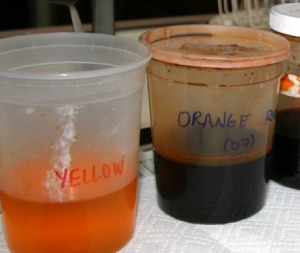
PROS: Free. Heat tolerant. Ubiquitous. Leakproof. Unbreakable. Stackable. Reusing them is a green thing to do.
CONS: None, really, except that jars may leak if not properly sealed and then tipped or dropped, and you may splash the dyes when trying to open them if not careful.

The jars can be found in any discount (K-Mart) or grocery store, and are sold under several brands. Ziploc and Gladware are the two national brands I’m familiar with, and they look a little bit more flashy than the store brands. They usually retail for about $3.00 to $3.50 for a set of two quart jars or three pint jars (with lids). If you’re lucky, you can come upon a sale and get them much cheaper.
There are also totally acceptable store brands available, which work just as well and are usually a bit cheaper than the national brands. Gordon Food Service has a store brand jar that is cheap (~$1 each in packs of 5) and as good as the Ziploc jars. Do AVOID the cheap knock-offs that are sold in dollar stores–they may or may not be heat tolerant, and I have been told that they are definitely NOT leak-proof.
The base of most of the jars (like the ZipLoc jars pictured left) is narrower than the lid, so they can be safely stacked one on top of another on your dye table (as they are on mine), on shelves, or in your dye cabinet. I have found that these jars are the right width to store 3 across and 5 deep in a legal sized file cabinet. The height is such that you can stack three pints or a pint and a quart. In a single drawer you can store up to 45 jars of dye.
The jars have metric and English measurement markings on the sides, making it easy to pour the appropriate amount of boiling water in to mix up dyes.
The best feature, though, is the screw-on top. This offers the best possible seal, and prevents both spillage and evaporation.
The lids are often dark (although lately I’ve been finding bright orange ones), so I write the name of the dye on them with a silver Sharpie marker. I usually label the jar itself with the dye package, as above, and date it.

I haven’t seen or tried the small version of the Lockware jar, but suspect it will be too shallow to be useful for most eggs.
PROS: Heat tolerant. Ubiquitous. Leakproof. Unbreakable. Stackable. Screw top lids.
CONS: Small cost to purchase.
Back to Main Dyes page
Back to Main Pysankarstvo page
Search my site with Google
Storage Containers




